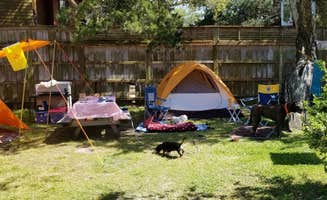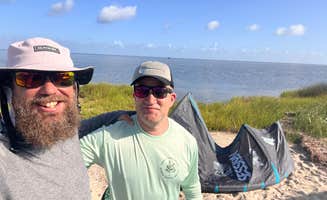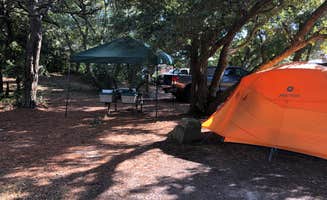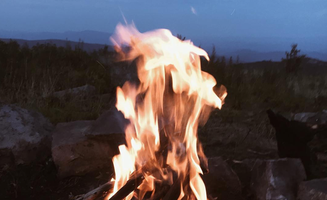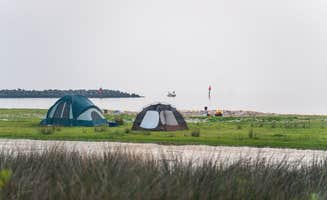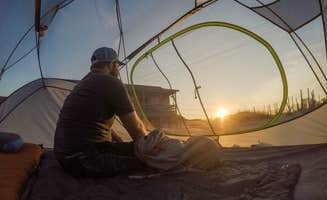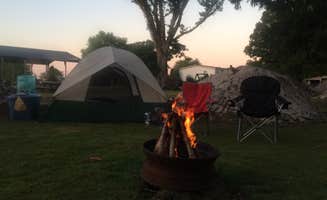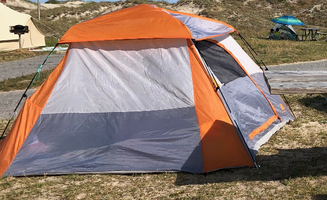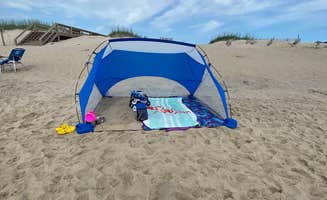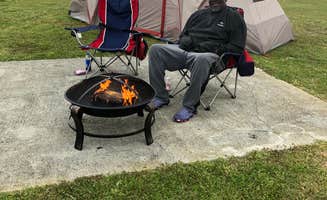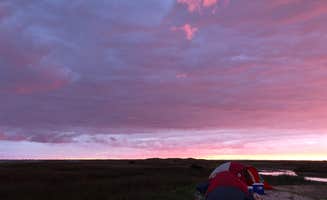Ocracoke Island campgrounds operate primarily from April through November, with most sites closing during winter months due to harsh coastal conditions and reduced services. The island's camping options balance between National Park Service facilities with minimal amenities and privately operated campgrounds offering more extensive hookups. The flat, low-lying terrain creates particular drainage challenges during storms, and wind exposure affects nearly all camping locations regardless of their position on the island.
What to do
Beach fishing and surf fishing: Both Frisco Campground and beaches near Ocracoke offer excellent fishing opportunities. "There's amazing, world-famous fishing in the area, so in Spring and Fall this place can be packed and hard to get a reservation," notes a Frisco camper. The area provides both ocean and sound-side fishing options.
Bicycling through town: Many visitors rent bikes to explore Ocracoke Village. At Teeter's Campground, "You can rent bikes next door at the Dockmaster. $10/bike for 2 hours. Total deal," according to a camper. The compact village layout makes cycling an efficient transportation method.
Sunrise ocean viewing: Early risers can experience stunning Atlantic sunrises. One camper at Ocracoke Campground shared, "We woke up at 5:30 to watch the sunrise over the ocean which was just a hop, skip and jump away from our tent. It was paradise." Sunset viewing over the sound side offers equally remarkable experiences.
What campers like
Direct beach proximity: Ocracoke Campground receives praise for its oceanfront location. "There is just a short walk to one of the most beautiful beaches in the United States," writes one visitor. Sites on outer loops typically offer the shortest beach access routes, often via wooden walkways over protective dunes.
Ocean soundscapes: Many campers appreciate falling asleep to natural ocean sounds. "This is a very unique and well maintained campground. Literally on the dunes and beach," notes a reviewer who enjoyed the auditory experience of camping so close to the Atlantic.
Loop D sites at Cape Point: Cape Point Campground has specific areas recommended by regular visitors. "I stayed in site D-17 and recommend any of those sites on the outer perimeter of D loop," advises a camper who enjoyed a five-night stay. These sites typically offer better positioning relative to prevailing winds.
What you should know
Sand spurs and cacti: Several campgrounds present unexpected hazards for tent campers. At Frisco Woods Campground, "There are small cacti and sand spurs everywhere. We could not walk our 3 dogs at all! When they did go potty we spent several minutes picking out sands spurs and cacti from their paws and fur." Tent campers should bring heavy-duty ground tarps.
Limited bathroom facilities: Facilities vary significantly between campgrounds. At Teeter's Campground, "There are just 2 bathroom stalls for the entire campground but they were very clean and the shower has hot water." National seashore campgrounds typically provide cold-water showers only.
Water accumulation issues: Low-lying campsites experience drainage problems during heavy rain. A camper at Jerniman's noted, "Serious water and drainage issues, sewer dump station was a joke." Request higher-elevation sites when possible, particularly during storm seasons.
Fall and spring are ideal seasons: Summer brings intense heat, humidity, and insects. "It's a little too hot in July and August so we tend to avoid it during those months," explains a Frisco camper. Spring and fall offer more moderate temperatures with fewer insect concerns.
Tips for camping with families
Pool access options: Cape Hatteras KOA offers excellent water amenities for families. "They have a really nice pool area with zero entry and two small waterslides for the kids," notes a reviewer. The pool provides a freshwater alternative to ocean swimming, particularly valuable on windy beach days.
Scheduled activities: Some private campgrounds organize regular children's events. Cape Hatteras KOA "had scheduled fun activities throughout the week," reports a camper, though "some required an extra fee." Check activity schedules upon arrival as programs vary seasonally.
Bike-friendly environments: Multiple campgrounds provide safe spaces for children to ride bicycles. "My wife and I feel comfortable with the kids riding their bikes all over the facility," shares a KOA visitor. Ocracoke Village's minimal traffic makes it particularly suitable for family cycling.
Tips from RVers
Site positioning considerations: At Hatteras Sands Campground, "Picnic and grill were on the opposite side of our travel trailer door so not ideal setup at all. Major drop off on side and back of our space." Request detailed site information when booking, particularly regarding hookup and amenity placement.
Premium waterfront sites: Several campgrounds offer premium waterfront options. "The sites along the waterway would be nicest," notes a Hatteras Sands reviewer. Water-view sites typically cost more but provide improved ventilation and scenic value.
Limited big rig accessibility: Some campgrounds present challenges for larger vehicles. At Frisco Woods, "Parking a large rig might be difficult because of the narrow width of the road." Call ahead to confirm turning radius requirements and site dimensions for vehicles over 30 feet.



